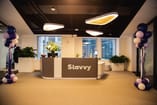Forget what you think you know about the insurance industry.
At least, that’s one thing that members of Acrisure Innovation’s engineering team tells new hires. “This industry has been around for centuries, but that makes for some very interesting problems that have never been solved with technology,” said Engineering Lead Aditya Kumar. “There’s so much interesting stuff you can do in a ‘boring’ industry that hasn’t yet been tech enabled.”
As the world of insurance modernizes, Kumar is excited about where Acrisure Innovation fits in the big picture — not only in terms of advancing the industry through the power of data and artificial intelligence, but also as a small-scale team of technologists under the umbrella of insurance brokerage firm Acrisure as they push into a larger FinTech space.
“We enable all of the companies within the Acrisure organization to scale, grow and succeed in this new world where technology gives you more horsepower,” explained Kumar.
One area of promising growth lies in the relationship between the companies under Acrisure and the vast collections of data they collect and produce. When you zoom into that intersection, the problem comes down to siloing — and that’s where Acrisure Innovation’s engineering team is stepping in. “We’re trying to harness the network effect within Acrisure,” said Kumar.
With more than 600 agencies to assist, Kumar and his team are asking an important question: How do they use this data to unveil existing collaborative opportunities for these companies that are otherwise successful in isolation? “We’re democratizing this data and making it available across the agencies to give them the power of knowing who to work with — who the experts are on things they’re not experts at — and seeing how that generates ideas and solutions,” he explained.
With overhead support from Acrisure, Acrisure Innovation has the flexibility and security to operate as its own startup-like tech ecosystem, complete with bountiful resources and large-scale projects — all of which pour back into the company as a whole. To learn more about their operations, team environment and culture — and how together, they’re shifting the future of the insurance industry’s technological capabilities — Built In sat down with Kumar and his fellow teammates, Senior Director of Engineering Deidre Harvego and Software Engineer Gabby Wright.

What is it like to operate under the umbrella of a larger company?
Kumar: Acrisure brings together powerful organizations, but gives them the autonomy to do things their own way. If there’s something happening at the parent company, we can leverage it, or we can choose to say, “That doesn’t work for us — we’re going to do things a slightly different way.”
Having these options is important, especially in technology. Acrisure’s superpower is that they’re willing to bring in disparate systems, let them thrive and only integrate them where it makes sense productively. What that really means is, Acrisure Innovation is behaving like a startup within a much larger company. We have the funding we need from the home office, and they give us the support we need, but we can do things in a much more agile way. We’re not dealing with the bureaucracy or baggage that comes from being a much larger organization.
Defining Acrisure Innovation’s company culture
How does Acrisure’s support allow your team to operate like a stable startup?
Wright: Our stability and freedom allows for a lot of experimentation. We are able to make mistakes and learn from them. And there are many opportunities for entry-level developers here to make a bigger impact more quickly, because we have the stability to allow them to do that.
Harvego: We’re a close-knit team at Acrisure Innovation. We also get to play with cool technology as we’re building out our solutions, and we’ve got a lot of support and interest in the types of things we’re building.
Kumar: I’ve been a part of two other startups where it was always about where the paychecks were coming from — how we were getting seed round funding and what we had to do to convince investors about a particular course of actions. At Acrisure Innovation, we’re careful with how we spend money, but we’re not doing things unnaturally. Our priority is: What do our customers need, and how can we provide that value?
How does working on a small-scale team of technologists at Acrisure Innovation compare to teams you’ve been on previously?
Harvego: At bigger companies, you need to have really well-defined swimlanes of who does what in order to operate more effectively. What is different about Acrisure Innovation, based upon our size and culture, is that we’ve got more opportunities to color outside the lines — or maybe the lines are a little more blurry in how we work together and solve problems.
What challenges come with working on a smaller team?
Kumar: You have to be more thoughtful in where you’re spending time. There are thousands of people across the Acrisure network, and we’re this small team that wants to solve all their problems. For example, if you look at our product vision, there are nearly 20 things we want to be doing, but we have to pick four or five of them, because that’s how many people we have to effectively work on them.
The other challenge is — and I think of this as both a pro and a reason why I joined — you get to play roles that you would otherwise probably never get the opportunity to play, which is great for growth. Right now, I’m playing a product owner. I have no idea what I’m doing, but I have other product owners in the organization who are really good at what they do and are helping me succeed at my job. An engineer, traditionally, would only do product ownership if they’re looking to switch into that. For me, this is a pleasant detour where I get to learn something low risk, have an impact and help the organization succeed.
Based upon our size and culture, we’ve got more opportunities to color outside the lines.”
Gabby, as this is your first role out of college, what has the experience of working on a small team been like for you?
Wright: When I first got here, there were a lot of software engineering principles I didn’t understand. I spent hours on calls with members of my team as they gave me tutorials and helped me debug certain things. Everybody was willing to help. Less than a year into that, I was the one on the call doing the same thing with new hires. I really like the small-team environment and having a unique relationship with each person. I was also very surprised by how quickly I was able to have a big impact on everything. My ideas mattered from day one.
Share a story that illustrates what Acrisure Innovation’s work environment is like.
Wright: A couple of weeks ago, we ran into this hairy bug. I was debugging a lot that week, but this was something I hadn’t really worked on before. I ended up hopping on a call with the last person on my team who worked on that code. We started pair programming and debugging together. Somewhere along the way, we got a third member of our team with more front-end experience to hop on the call as well. At one point, all three of us were on the call having an impromptu meeting to try to debug this thing, and we were able to come up with a solution together. It’s a very collaborative environment.
Harvego: We had an all-company meeting this past March, which corresponded with South by Southwest, where our CEO Greg Williams was speaking. This particular meeting was really cool, because Greg Williams came and spoke to us. We had a very interactive Q&A with him, and it really emphasized not only the importance of what we work on, but also the communication and connection he created in taking the time to interact with us.

How does your access to ample resources impact the approach you take on projects?
Harvego: To Adi’s earlier point, we don’t have to figure out how to directly fund the company ourselves, which enables us to not only build things that are going to scale, but also build things responsibly in terms of how we use resources — whether we buy, lease or build something ourselves. We don’t have to be scrappy — we’re able to make decisions based on what’s right for Acrisure.
Kumar: We have the resources we need, but we’re smart about how we leverage them. We’re not going to provision a resource to be gigantic just to make our lives easier. If I find a tool that makes my day to day easier or makes us more productive, we’re going to make it happen. No one has to find ways to work around things that would make them immediately efficient. We also try to provide funding for education so that, as you’re considering what resources you need, you also have the learning resources you need.
Our stability and freedom allows for a lot of experimentation.”
What types of data or AI-driven projects can new hires expect to work on?
Harvego: Insurance is much more complex than I had anticipated — in a good way. If you think about the carriers that provide insurance and the people or companies who need insurance, there’s a really interesting supply and demand that we sit in between. It’s a double-sided marketplace. We’re figuring out how to optimize the right connection between the supply and the demand of insurance, which leads to interesting AI optimizations. And ultimately, we’ll be working on this for a very long time.







